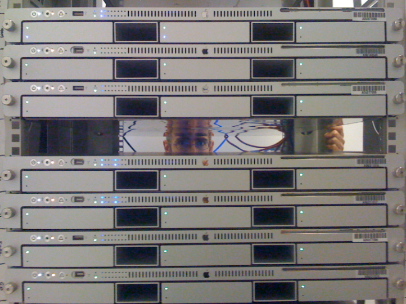Following Apple’s announcement of the XServe’s cancellation yesterday, there has been an expected amount of chatter revolving around Apple’s server-oriented efforts in general, and also specifically about Apple’s software and hardware offerings. As somebody who has lived and worked in the Apple IT world for a good while, here are some thoughts.
Over the years, there have been (in my opinion) two primary use cases for Mac OS X Server which both stem from the same underlying concept: any place where there are more than a few macs, those macs can benefit from some form of centralized binding element. The more macs there are, the greater the possible benefit. The two use cases I see are: 1) to provide a turnkey client management solution, and 2) to provide turnkey services. I hate the word ‘turnkey’ cause it sounds blingy, but in this case I mean it: the ratio of ‘ease of use’ to ‘features provided’ is definitely the key metric, and the key ‘win’ for OSXS.
The management use case has opened up a lot since ye old days, and now there are a variety of ways to perform client management that don’t even require Mac OS X Server. However, I would still argue (tentatively, as somebody who doesn’t do a lot of client management these days) that OSXS still provides the best ratio of ease of use to features provided, for client management. The need for client management absolutely still exists, and now there are more options. This is a good thing.
The ‘services’ side is more significant now than it used to be, because it wasn’t until the more recent server releases that OSXS provided services that really broke through and attained critical mass (this is mostly gauged by observing the mac IT community and its users). In my opinion, it’s not that Apple makes the best single wiki, calendar, mail, file, podcast production(, …) service, but that they are pretty good, integrated in one box, and … sigh… ‘turnkey’.
Time is money. Money is money, too. It’s pretty easy for a geek to be all like “pshaw, I don’t need all the autoconfiguration glue crutch annoyance water wing bumper car stuff that you call ‘added value’, I has the power of open source!”, and then proceed to provide all the solutions that are needed using a potpourri of software and perhaps even hardware. Usually, the skilled open source person wins in terms of the ‘absolute value’ of the features provided, and pretty much always loses in terms of the ratio of ease of use (from the implementor’s perspective) to features provided. “Ease of use” is important because it expands to “time, money”, but it’s easy to overlook as a skilled (especially open source) professional, because “easy” is a relative concept, and because *time* is a relative concept. Geeks might not mind plugging away at ${annoying_technical_challenge} all day long, where as most normal people would never think of it.
Of course, it’s possible to get off into the weeds with just about anything related to computers – and this certainly includes OSXS. However, with the right OSXS approach, it’s absolutely possible to deploy and maintain useful solutions, and only expend minimal time and money in the process. Many OSXS sites fit this description exactly, and many OSXS consultants make their living based on this concept.
I used to run my own private instances of all the network services I cared about, on a FreeBSD colo box on which I had root. It was fun for a while, and a great learning experience. Eventually it turned from fun to janitorial in nature – that’s when I got my DreamHost account, and I haven’t looked back. I now prefer the solution that conserves time and money while, and I still think that’s the primary win for OSXS, for its target audience.
The XServe will be missed, though. It’s some kickass hardware. For the people who actually have racks of XServes, eventually something will have to give. It’s simple physics :) Mac sales are only going up, so the big picture isn’t a lot different than it was last week in terms of *needs*. In terms of *options*, it is different. Just as the death of Apple’s XServe RAID did not spell the death of direct-attached storage for Macs, I’m hoping the same will be true for high-density datacenter-grade OSXS deployments. I’m as curious as anybody to see how this plays out…
